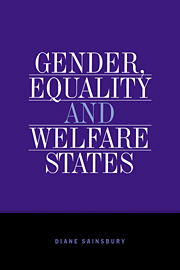Book contents
- Frontmatter
- Contents
- List of figures
- List of tables
- Acknowledgments
- Introduction
- Part I Dimensions of variation
- Part II Bases of entitlement
- Part III Stratification and redistributive outcomes
- Part IV Welfare state restructuring
- 8 Gender equality reforms and their impact
- 9 Welfare state retrenchment
- Notes
- References
- Index
8 - Gender equality reforms and their impact
Published online by Cambridge University Press: 18 September 2009
- Frontmatter
- Contents
- List of figures
- List of tables
- Acknowledgments
- Introduction
- Part I Dimensions of variation
- Part II Bases of entitlement
- Part III Stratification and redistributive outcomes
- Part IV Welfare state restructuring
- 8 Gender equality reforms and their impact
- 9 Welfare state retrenchment
- Notes
- References
- Index
Summary
Most discussions of welfare state restructuring during the past decade have reflected the view that the welfare state is in crisis, and that retrenchment measures are necessary. With this emphasis, little attention has been given to a possible restructuring of welfare states through gender equality reforms. Since the 1970s reforms to promote equality between the sexes have been on the policy agenda, and several countries have enacted reform legislation. Although evaluations and feminist critiques of the reforms exist for individual countries, along with surveys of international trends in social legislation (e.g. Brocas et al. 1990), gender equality reforms and their impact have seldom been analyzed from a cross-national perspective.
The object of this chapter is a comparative appraisal of gender equality reforms, focusing on their impact in terms of outcomes for women and men. At issue are two interlocking questions. The first is the extent to which the reforms of the past two decades have altered the patterns of inequality in women's and men's social rights described in the earlier chapters. The second is the nature and degree of change in the gendered differentiation of entitlements. The answers to these questions shed light on variations in welfare state restructuring affecting gender relations since the late 1960s. They also help us to understand which reforms have worked and which reforms have not – and the extent to which policies have evolved toward the individual model of social policy.
Reforms and outcomes
A useful point of departure in thinking about reforms to achieve parity in the social rights of women and men is a typology of strategies to influence gender relations, suggested by Prue Chamberlayne (1993).
- Type
- Chapter
- Information
- Gender, Equality and Welfare States , pp. 173 - 197Publisher: Cambridge University PressPrint publication year: 1996



